Know Your Terms: Holistic, Analytic, and Single-Point Rubrics
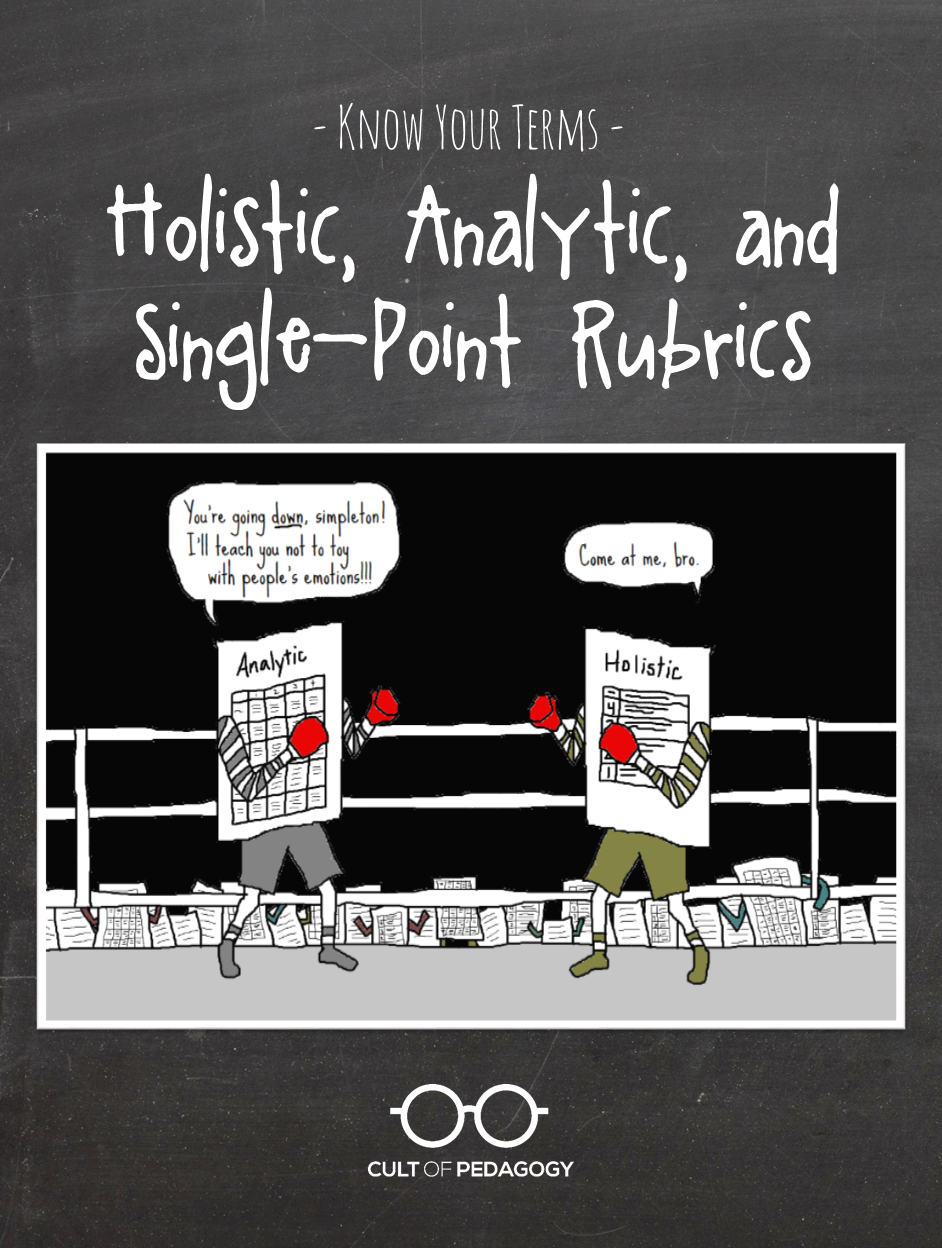
Whether you’re new to rubrics, or you just don’t know their formal names, it may be time for a primer on rubric terminology.
So let’s talk about rubrics for a few minutes. What we’re going to do here is describe two frequently used kinds of rubrics, holistic and analytic, plus a less common one called the single-point rubric (my favorite, for the record). For each one, we’ll look at an example and explore its pros and cons.
Off we go!
Holistic Rubrics
A holistic rubric is the most general kind. It lists three to five levels of performance, along with a broad description of the characteristics that define each level. The levels can be labeled with numbers (such as 1 through 4), letters (such as A through F) or words (such as Beginning through Exemplary). What each level is called isn’t what makes the rubric holistic — it’s the way the characteristics are all lumped together.
Suppose you’re an unusually demanding person. You want your loved ones to know what you expect if they should ever make you breakfast in bed. So you give them this holistic rubric:
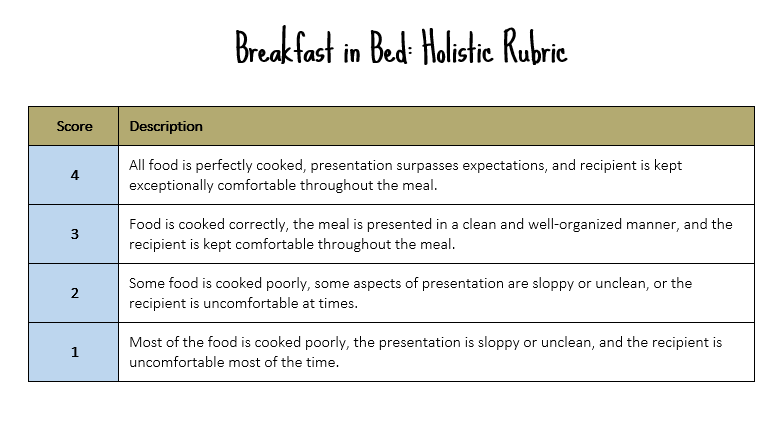
When your breakfast is done, you simply gather your loved ones and say, “I’m sorry my darlings, but that breakfast was just a 2. Try harder next time.”
The main advantage of a holistic rubric is that it’s easy on the teacher — in the short run, anyway. Creating a holistic rubric takes less time than the others, and grading with one is faster, too. You just look over an assignment and give one holistic score to the whole thing.
The main disadvantage of a holistic rubric is that it doesn’t provide targeted feedback to students, which means they’re unlikely to learn much from the assignment. Although many holistic rubrics list specific characteristics for each level, the teacher gives only one score, without breaking it down into separate qualities. This often leads the student to approach the teacher and ask, “Why did you give me a 2?” If the teacher is the explaining kind, he will spend a few minutes breaking down the score. If not, he’ll say something like, “Read the rubric.” Then the student has to guess which factors had the biggest influence on her score. For a student who really tries hard, it can be heartbreaking to have no idea what she’s doing wrong.
Holistic rubrics are most useful in cases when there’s no time (or need, though that’s hard to imagine) for specific feedback. You see them in standardized testing — the essay portion of the SAT is scored with a 0-6 holistic rubric. When hundreds of thousands of essays have to be graded quickly, and by total strangers who have no time to provide feedback, a holistic rubric comes in handy.
Analytic Rubrics
An analytic rubric breaks down the characteristics of an assignment into parts, allowing the scorer to itemize and define exactly what aspects are strong, and which ones need improvement.
So for the breakfast in bed example, an analytic rubric would look like this:
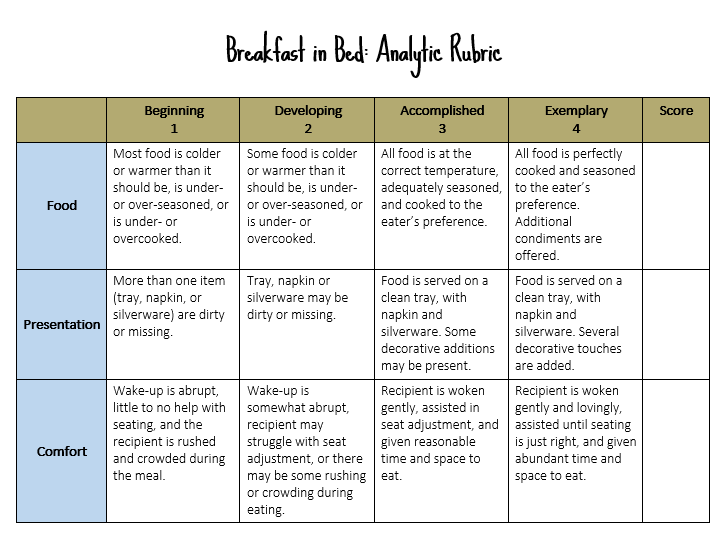
In this case, you’d give your loved ones a separate score for each category. They might get a 3 on Presentation, but a 2 on Food and just a 1 on Comfort. To make feedback even more targeted, you could also highlight specific phrases in the rubric, like, “the recipient is crowded during the meal” to indicate exactly what went wrong.
This is where we see the main advantage of the analytic rubric: It gives students a clearer picture of why they got the score they got. It is also good for the teacher, because it gives her the ability to justify a score on paper, without having to explain everything in a later conversation.
Analytic rubrics have two significant disadvantages, however: (1) Creating them takes a lot of time. Writing up descriptors of satisfactory work — completing the “3” column in this rubric, for example — is enough of a challenge on its own. But to have to define all the ways the work could go wrong, and all the ways it could exceed expectations, is a big, big task. And once all that work is done, (2) students won’t necessarily read the whole thing. Facing a 36-cell table crammed with 8-point font is enough to send most students straight into a nap. And that means they won’t clearly understand what’s expected of them.
Still, analytic rubrics are useful when you want to cover all your bases, and you’re willing to put in the time to really get clear on exactly what every level of performance looks like.
Single-Point Rubrics
A single-point rubric is a lot like an analytic rubric, because it breaks down the components of an assignment into different criteria. What makes it different is that it only describes the criteria for proficiency; it does not attempt to list all the ways a student could fall short, nor does it specify how a student could exceed expectations.
A single-point rubric for breakfast in bed would look like this:
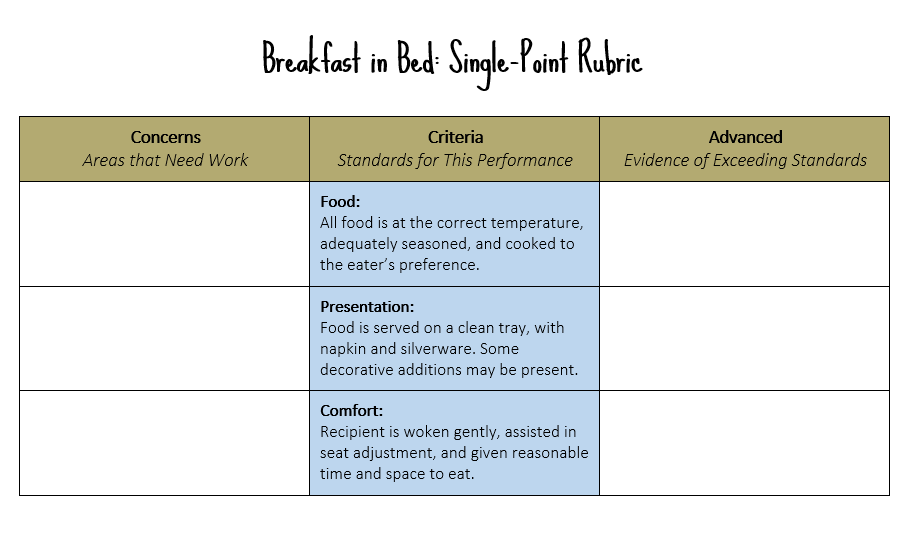
Notice that the language in the “Criteria” column is exactly the same as the “3” column in the analytic rubric. When your loved ones receive this rubric, it will include your written comments on one or both sides of each category, telling them exactly how they fell short (“runny eggs,” for example) and how they excelled (“vase of flowers”). Just like with the analytic rubric, if a target was simply met, you can just highlight the appropriate phrase in the center column.
If you’ve never used a single-point rubric, it’s worth a try. In 2010, Jarene Fluckiger studied a collection of teacher action research studies on the use of single-point rubrics. She found that student achievement increased with the use of these rubrics, especially when students helped create them and used them to self-assess their work.
The single-point rubric has several advantages: (1) It contains far less language than the analytic rubric, which means students are more likely to read it and it will take less time to create, while still providing rich detail about what’s expected. (2) Areas of concern and excellence are open-ended. When using full analytic rubrics, I often find that students do things that are not described on the rubric, but still depart from expectations. Because I can’t find the right language to highlight, I find myself hand-writing justifications for a score in whatever space I can find. This is frustrating, time-consuming and messy. With a single-point rubric, there’s no attempt to predict all the ways a student might go wrong. Similarly, the undefined “Advanced” column places no limits on how students might stretch themselves. “If the highest level is already prescribed then creativity may be limited to that pre-determined level,” says Fluckiger. “Students may surprise us if we leave quality open-ended.”
The main disadvantage of single-point rubrics is that using them requires more writing on the teacher’s part. If a student has fallen short in many areas, completing that left-hand column will take more time than simply highlighting a pre-written analytic rubric.
Need Ready-Made Rubrics?
My Rubric Pack gives you four different designs in Microsoft Word and Google Docs formats. It also comes with video tutorials to show you how to customize them for any need, plus a Teacher’s Manual to help you understand the pros and cons of each style. Check it out here:
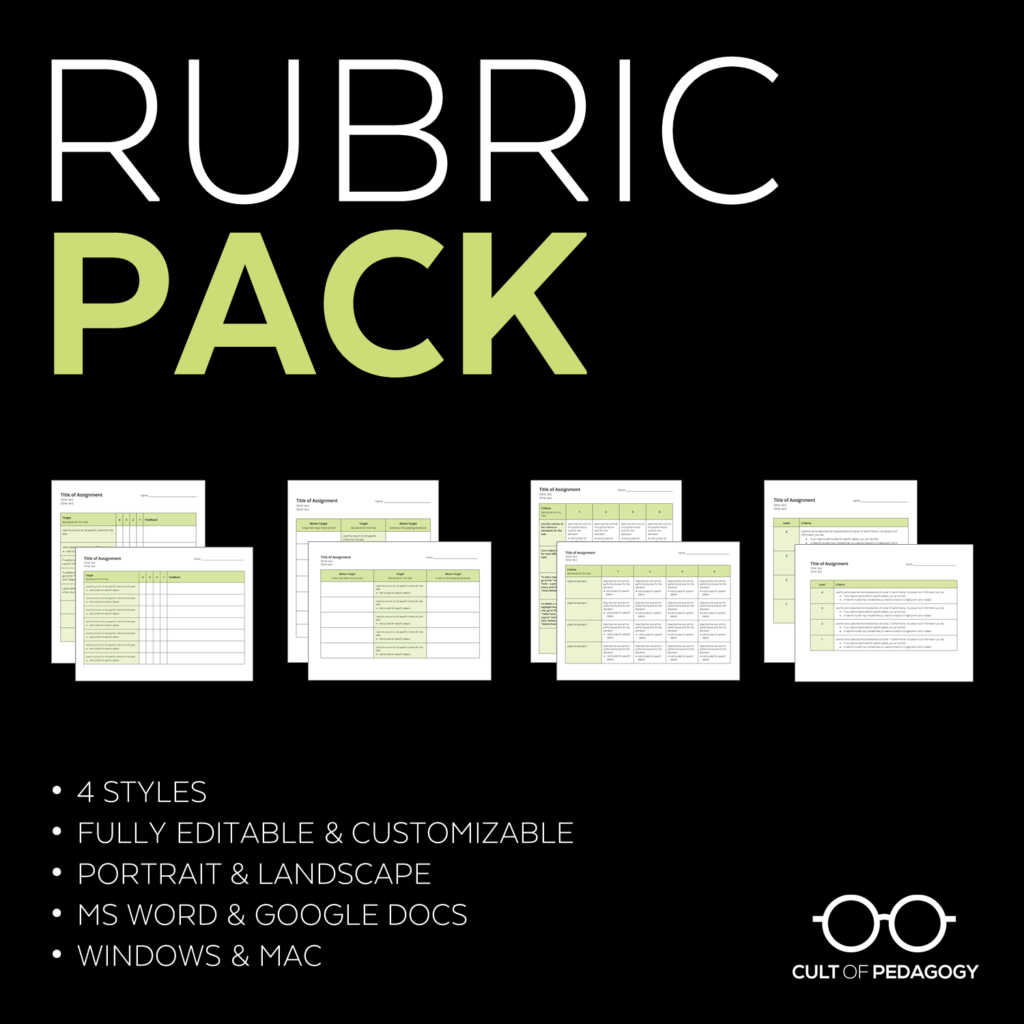
Sources:
Fluckiger, J. (2010). Single point rubric: A tool for responsible student self-assessment. Teacher Education Faculty Publications. Paper 5. Retrieved April 25, 2014 from http://digitalcommons.unomaha.edu/tedfacpub/5.
Mertler, C. A. (2001). Designing scoring rubrics for your classroom. Practical Assessment, Research & Evaluation, 7(25). Retrieved April 30, 2014 from http://PAREonline.net/getvn.asp?v=7&n=25.
Know Your Terms is my effort to build a user-friendly knowledge base of terms every educator should know. New items will be added on an ongoing basis. If you heard some term at a PD and didn’t want to admit you didn’t know what it meant, send it to me via the contact form and I’ll research it for you.
Join the Cult of Pedagogy mailing list and get weekly tips, tools, and inspiration—in quick, bite-sized packages—all geared toward making your teaching more effective and fun. You’ll get access to my members-only library of free downloadable resources, including my e-booklet, 20 Ways to Cut Your Grading Time in Half, which has helped thousands of teachers spend less time grading!